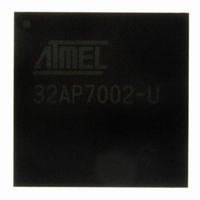AT32AP7002-CTUT Atmel, AT32AP7002-CTUT Datasheet - Page 167

AT32AP7002-CTUT
Manufacturer Part Number
AT32AP7002-CTUT
Description
IC MCU 32BIT AVR32 196-CBGA
Manufacturer
Atmel
Series
AVR®32 AP7r
Specifications of AT32AP7002-CTUT
Core Processor
AVR
Core Size
32-Bit
Speed
150MHz
Connectivity
EBI/EMI, I²C, MMC, PS2, SPI, SSC, UART/USART, USB
Peripherals
AC'97, DMA, I²C, LCD, POR, PWM, WDT
Number Of I /o
85
Program Memory Type
ROMless
Ram Size
32K x 8
Voltage - Supply (vcc/vdd)
1.65 V ~ 1.95 V
Data Converters
D/A 2x16b
Oscillator Type
Internal
Operating Temperature
-40°C ~ 85°C
Package / Case
196-CBGA
Data Bus Width
32 bit
Data Ram Size
32 KB
Interface Type
I2C, JTAG, PS2, SPI, SSC, UART, USART, USB
Maximum Clock Frequency
150 MHz
Number Of Timers
3
Maximum Operating Temperature
+ 85 C
Mounting Style
SMD/SMT
Minimum Operating Temperature
- 40 C
On-chip Dac
16 bit, 2 Channel
Package
196CTBGA
Device Core
AVR32
Family Name
AT32
Maximum Speed
150 MHz
Operating Supply Voltage
1.8|3.3 V
For Use With
ATAVRONEKIT - KIT AVR/AVR32 DEBUGGER/PROGRMMRATNGW100 - KIT AVR32 NETWORK GATEWAYATSTK1000 - KIT STARTER FOR AVR32AP7000
Lead Free Status / RoHS Status
Lead free / RoHS Compliant
Eeprom Size
-
Program Memory Size
-
Lead Free Status / Rohs Status
Details
Available stocks
Company
Part Number
Manufacturer
Quantity
Price
- Current page: 167 of 896
- Download datasheet (13Mb)
17.5
17.5.1
32054F–AVR32–09/09
Functional Description
Basic Definitions
Source peripheral: Device on a System Bus layer from where the DMACA reads data, which is
then stored in the channel FIFO. The source peripheral teams up with a destination peripheral to
form a channel.
Destination peripheral: Device to which the DMACA writes the stored data from the FIFO (pre-
viously read from the source peripheral).
Memory: Source or destination that is always “ready” for a DMA transfer and does not require a
handshaking interface to interact with the DMACA. A peripheral should be assigned as memory
only if it does not insert more than 16 wait states. If more than 16 wait states are required, then
the peripheral should use a handshaking interface (the default if the peripheral is not pro-
grammed to be memory) in order to signal when it is ready to accept or supply data.
Channel: Read/write datapath between a source peripheral on one configured System Bus
layer and a destination peripheral on the same or different System Bus layer that occurs through
the channel FIFO. If the source peripheral is not memory, then a source handshaking interface
is assigned to the channel. If the destination peripheral is not memory, then a destination hand-
shaking interface is assigned to the channel. Source and destination handshaking interfaces can
be assigned dynamically by programming the channel registers.
Master interface: DMACA is a master on the HSB bus reading data from the source and writing
it to the destination over the HSB bus.
Slave interface: The HSB interface over which the DMACA is programmed. The slave interface
in practice could be on the same layer as any of the master interfaces or on a separate layer.
Handshaking interface: A set of signal registers that conform to a protocol and handshake
between the DMACA and source or destination peripheral to control the transfer of a single or
burst transaction between them. This interface is used to request, acknowledge, and control a
DMACA transaction. A channel can receive a request through one of three types of handshaking
interface: hardware, software, or peripheral interrupt.
Hardware handshaking interface: Uses hardware signals to control the transfer of a single or
burst transaction between the DMACA and the source or destination peripheral.
Software handshaking interface: Uses software registers to control the transfer of a single or
burst transaction between the DMACA and the source or destination peripheral. No special
DMACA handshaking signals are needed on the I/O of the peripheral. This mode is useful for
interfacing an existing peripheral to the DMACA without modifying it.
Peripheral interrupt handshaking interface: A simple use of the hardware handshaking inter-
face. In this mode, the interrupt line from the peripheral is tied to the dma_req input of the
hardware handshaking interface. Other interface signals are ignored.
Flow controller: The device (either the DMACA or source/destination peripheral) that deter-
mines the length of and terminates a DMA block transfer. If the length of a block is known before
enabling the channel, then the DMACA should be programmed as the flow controller. If the
length of a block is not known prior to enabling the channel, the source or destination peripheral
needs to terminate a block transfer. In this mode, the peripheral is the flow controller.
Flow control mode (CFGx.FCMODE): Special mode that only applies when the destination
peripheral is the flow controller. It controls the pre-fetching of data from the source peripheral.
AT32AP7002
167
Related parts for AT32AP7002-CTUT
Image
Part Number
Description
Manufacturer
Datasheet
Request
R

Part Number:
Description:
DEV KIT FOR AVR/AVR32
Manufacturer:
Atmel
Datasheet:

Part Number:
Description:
INTERVAL AND WIPE/WASH WIPER CONTROL IC WITH DELAY
Manufacturer:
ATMEL Corporation
Datasheet:

Part Number:
Description:
Low-Voltage Voice-Switched IC for Hands-Free Operation
Manufacturer:
ATMEL Corporation
Datasheet:

Part Number:
Description:
MONOLITHIC INTEGRATED FEATUREPHONE CIRCUIT
Manufacturer:
ATMEL Corporation
Datasheet:

Part Number:
Description:
AM-FM Receiver IC U4255BM-M
Manufacturer:
ATMEL Corporation
Datasheet:

Part Number:
Description:
Monolithic Integrated Feature Phone Circuit
Manufacturer:
ATMEL Corporation
Datasheet:

Part Number:
Description:
Multistandard Video-IF and Quasi Parallel Sound Processing
Manufacturer:
ATMEL Corporation
Datasheet:

Part Number:
Description:
High-performance EE PLD
Manufacturer:
ATMEL Corporation
Datasheet:

Part Number:
Description:
8-bit Flash Microcontroller
Manufacturer:
ATMEL Corporation
Datasheet:

Part Number:
Description:
2-Wire Serial EEPROM
Manufacturer:
ATMEL Corporation
Datasheet:











